主谓一致
图片预览
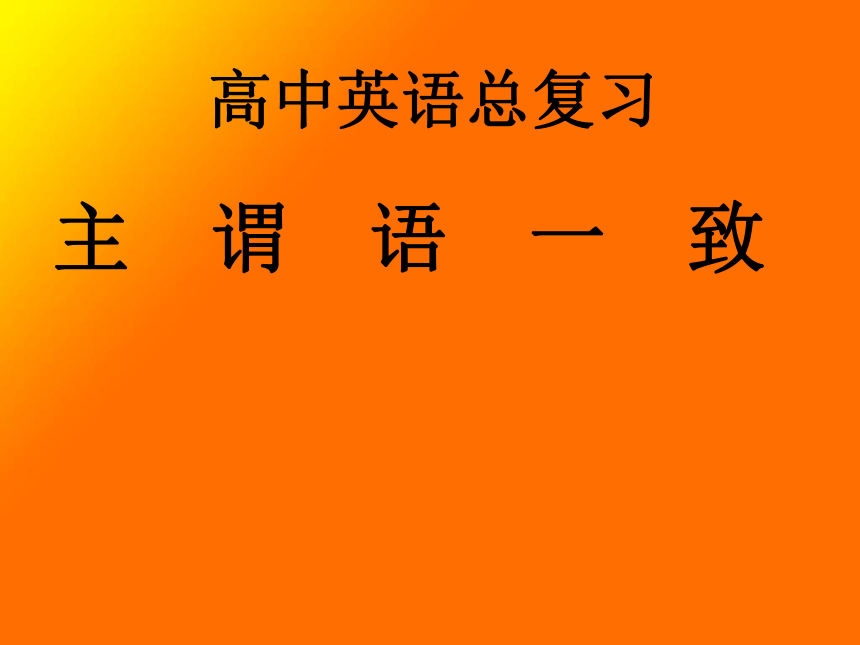
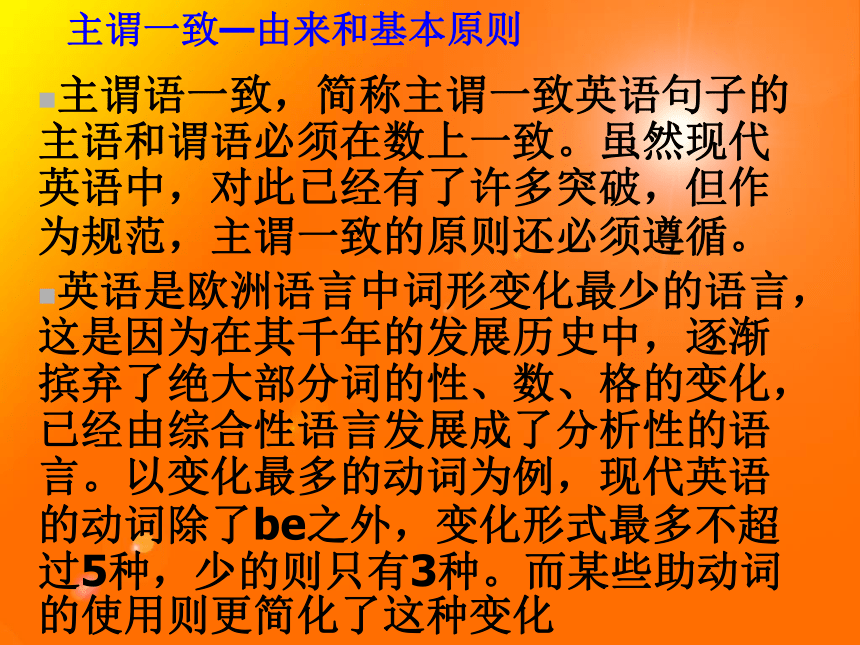
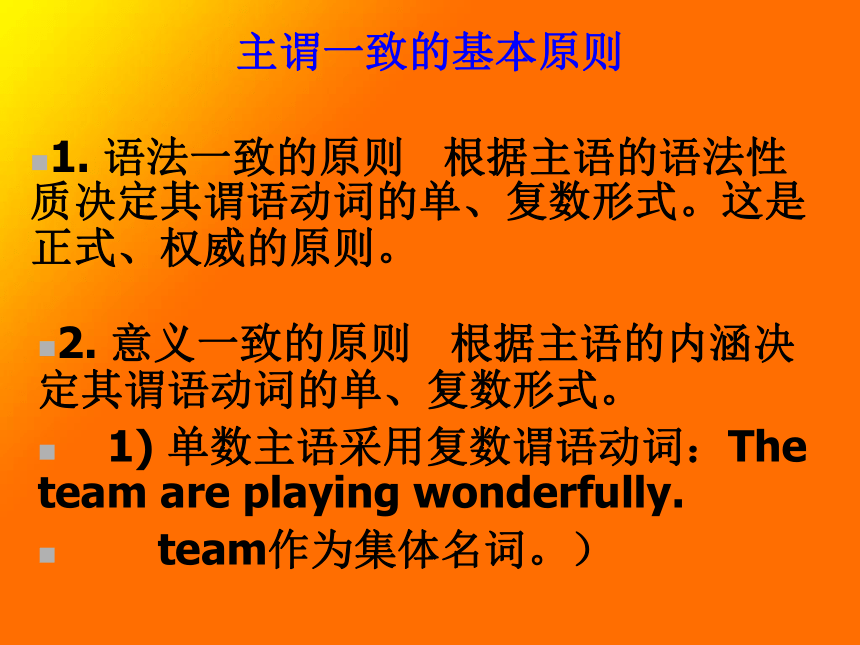
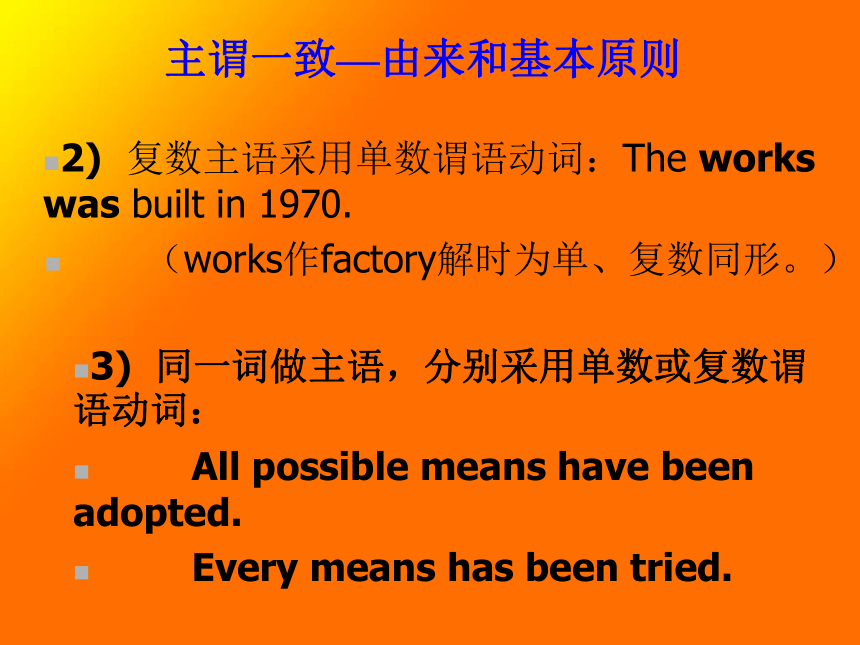
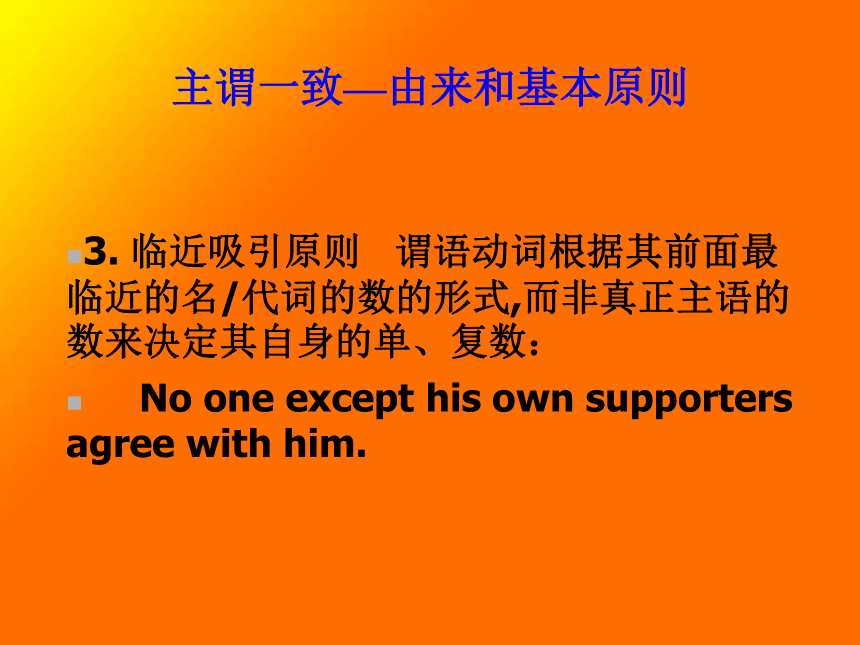
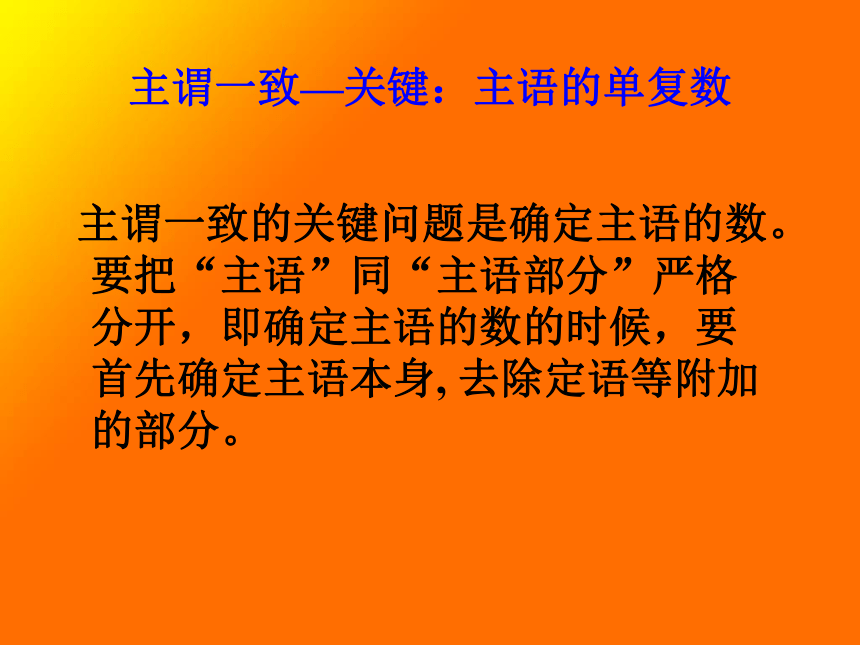
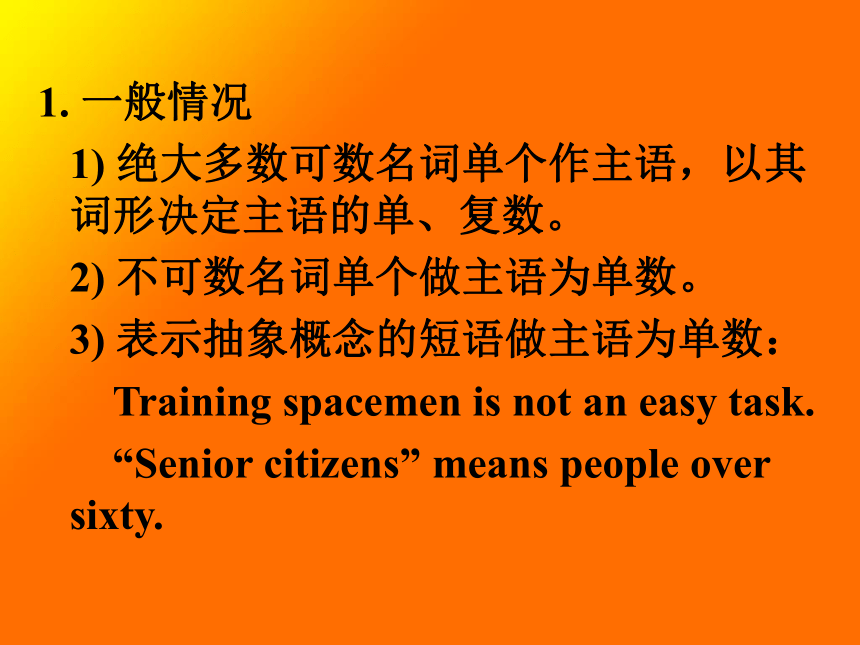
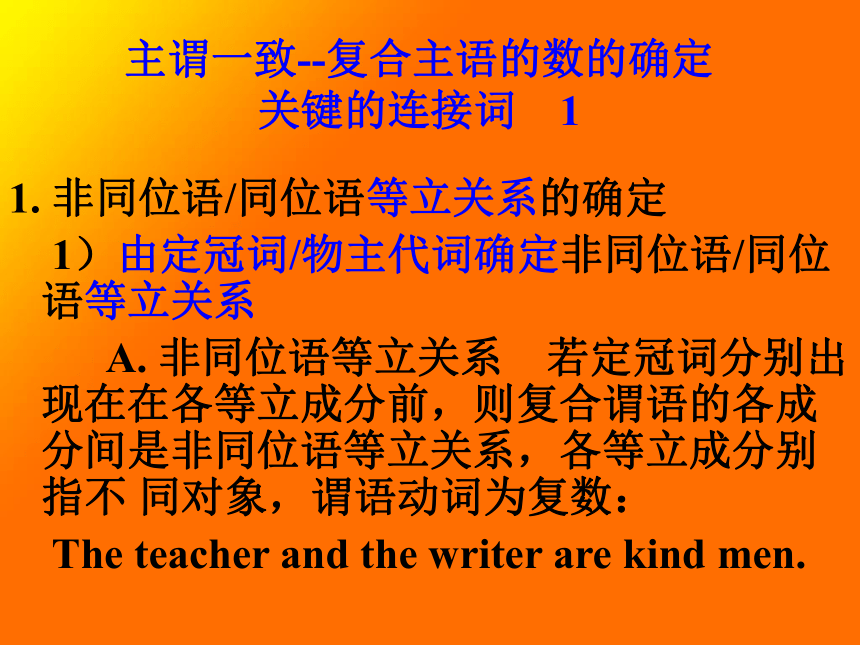
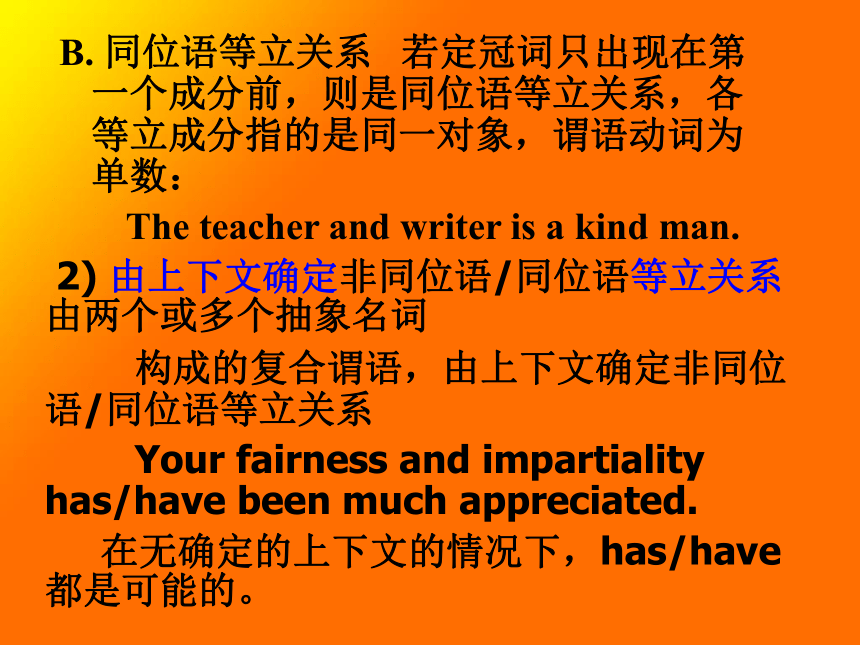
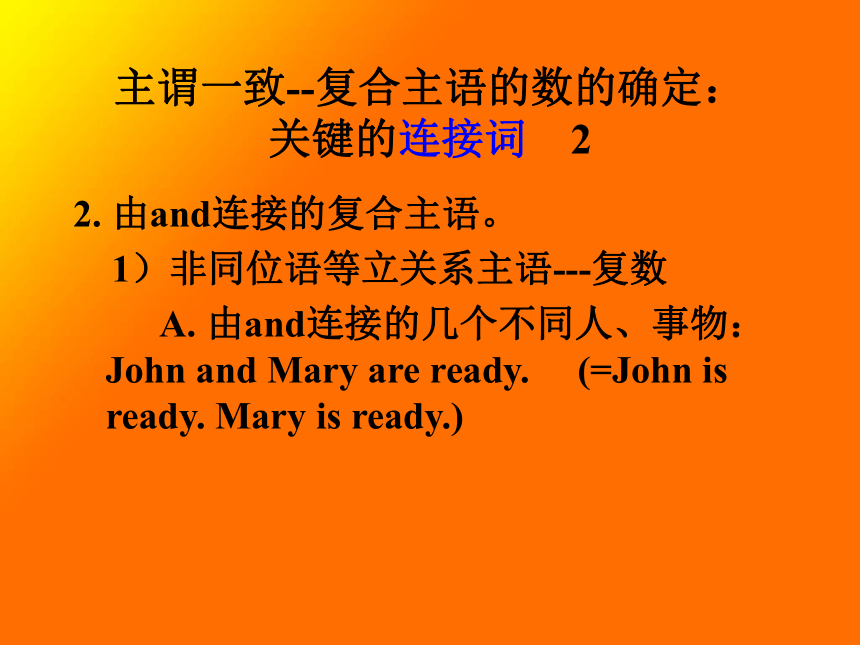
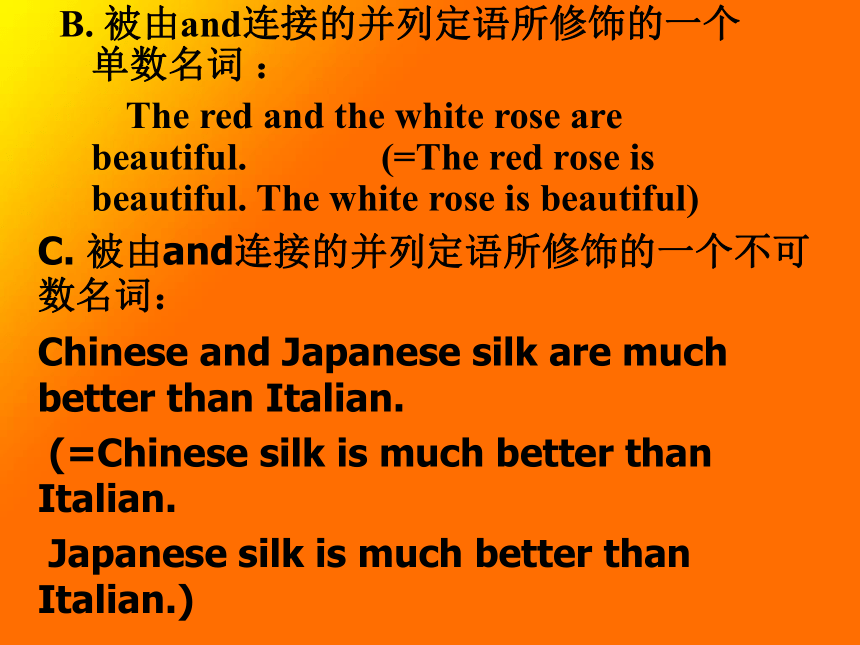
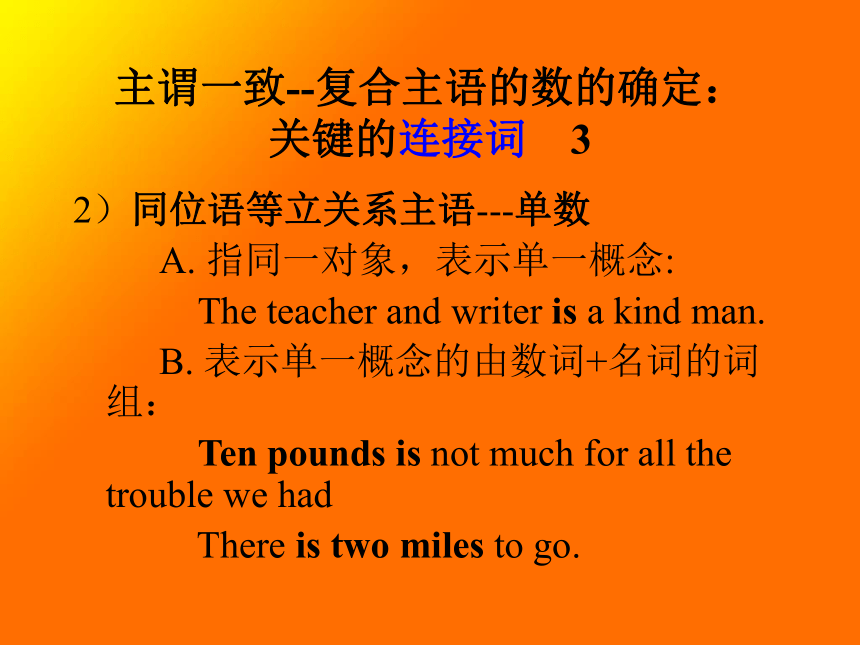
文档简介
课件38张PPT。高中英语总复习
主 谓 语 一 致主谓一致—由来和基本原则主谓语一致,简称主谓一致英语句子的主语和谓语必须在数上一致。虽然现代英语中,对此已经有了许多突破,但作为规范,主谓一致的原则还必须遵循。
英语是欧洲语言中词形变化最少的语言,这是因为在其千年的发展历史中,逐渐摈弃了绝大部分词的性、数、格的变化,已经由综合性语言发展成了分析性的语言。以变化最多的动词为例,现代英语的动词除了be之外,变化形式最多不超过5种,少的则只有3种。而某些助动词的使用则更简化了这种变化主谓一致的基本原则1. 语法一致的原则 根据主语的语法性质决定其谓语动词的单、复数形式。这是正式、权威的原则。2. 意义一致的原则 根据主语的内涵决定其谓语动词的单、复数形式。
1) 单数主语采用复数谓语动词:The team are playing wonderfully.
team作为集体名词。)主谓一致—由来和基本原则2) 复数主语采用单数谓语动词:The works was built in 1970.
(works作factory解时为单、复数同形。)3) 同一词做主语,分别采用单数或复数谓语动词:
All possible means have been adopted.
Every means has been tried.
主谓一致—由来和基本原则3. 临近吸引原则 谓语动词根据其前面最临近的名/代词的数的形式,而非真正主语的数来决定其自身的单、复数:
No one except his own supporters agree with him.
主谓一致—关键:主语的单复数 主谓一致的关键问题是确定主语的数。 要把“主语”同“主语部分”严格分开,即确定主语的数的时候,要首先确定主语本身, 去除定语等附加的部分。1. 一般情况
1) 绝大多数可数名词单个作主语,以其词形决定主语的单、复数。
2) 不可数名词单个做主语为单数。
3) 表示抽象概念的短语做主语为单数:
Training spacemen is not an easy task.
“Senior citizens” means people over sixty.
主谓一致--复合主语的数的确定 关键的连接词 11. 非同位语/同位语等立关系的确定
1)由定冠词/物主代词确定非同位语/同位语等立关系
A. 非同位语等立关系 若定冠词分别出现在在各等立成分前,则复合谓语的各成分间是非同位语等立关系,各等立成分别指不 同对象,谓语动词为复数:
The teacher and the writer are kind men.
B. 同位语等立关系 若定冠词只出现在第一个成分前,则是同位语等立关系,各等立成分指的是同一对象,谓语动词为单数:
The teacher and writer is a kind man.
2) 由上下文确定非同位语/同位语等立关系 由两个或多个抽象名词
构成的复合谓语,由上下文确定非同位语/同位语等立关系
Your fairness and impartiality has/have been much appreciated.
在无确定的上下文的情况下,has/have都是可能的。
主谓一致--复合主语的数的确定: 关键的连接词 22. 由and连接的复合主语。
1)非同位语等立关系主语---复数
A. 由and连接的几个不同人、事物: John and Mary are ready. (=John is ready. Mary is ready.)B. 被由and连接的并列定语所修饰的一个单数名词 :
The red and the white rose are beautiful. (=The red rose is beautiful. The white rose is beautiful)C. 被由and连接的并列定语所修饰的一个不可数名词:
Chinese and Japanese silk are much better than Italian.
(=Chinese silk is much better than Italian.
Japanese silk is much better than Italian.)
主谓一致--复合主语的数的确定: 关键的连接词 32)同位语等立关系主语---单数
A. 指同一对象,表示单一概念:
The teacher and writer is a kind man.
B. 表示单一概念的由数词+名词的词组:
Ten pounds is not much for all the trouble we had
There is two miles to go.
3. 由or/ either…or/ neither… nor连接的选择性复合主语
1)肯定的选择性复合主语
A. 所连接的成分分别为单数,谓语动词用单数: Either John or Dick is going to do this work.
B. 所连接的成分分别为复数,谓语动词用复数:
Either the teachers or the students have misunderstood this.主谓一致--复合主语的数的确定: 关键的连接词 4C. 所连接的成分在数上不一致,则用下列三种方法使其主谓取得 一致。
a. 根据临近吸引原则 谓语动词与其前面最临近的词的数相一致:
One or two friends are coming tonight.
b. 使用无词形变化的助动词代替有词形变化的动词:
The mother or the children must/will leave at once.
c. 改变句子结构和词序,并作必要的省略:
Is the child or the parents to blame?可变成:
Is the child to blame, or the parents? 2)否定的选择性复合主语
A. 与肯定的选择性复合主语原则相同: Neither Tom nor Jane has done it.
The teacher nor the students are to blame for this.
Neither Tom nor Jane has done it. 可变成:
Tom hasn’t done it; neither has Jane.
B. 但实际上,若构成复合主语的各成分均为单数,谓语动词也大多使用复数:
Neither he nor I were there.
主谓一致--复合主语的数的确定: 关键的连接词 54. 由not…but/ not only …but 连接的复合主语 根据临近吸引原则, 谓语动词与其前面最临近的主语的数相一致:
Not (only)my father, but all of us are looking forward to the guest.5. 含有肯定和否定两部分的主语
谓语动词与肯定的主语一致:
You, not I, are the right man to carry out the plan.
主谓一致--复合主语的数的确定:关键的连接词 66. 含有“准连接词”的主语 准连接词,即with/ together with/
along with, as well as/ as much as, rather than/ no less
than, but/except, unlike, including。
1) 规范用法 谓语与准连接词前面的主语保持一致:
Nothing but stamps and envelops is for sale.
2) 口语用法 准连接词起作用与介词类似,将其后的成分与主 语隔开,含义与and相近,根据意义一致的原则,即使主语是单数,也可以用复数动词:
My brother with his wife, both looking very sad, were/was drinking at the bar.
7. 例外情况
1) 由and连接的复合主语 均使用复数动 词, 而非总是遵循临近吸引原
则 : My sister and I are/am fully aware.
2)由either…or/ neither… nor连接的复合主语用单、复数均可:
Neither he nor I am/are fully aware.
主谓一致—不定代词做主语数的确定1 不定代词做主语数的确定
1. each
1)名词性 谓语动词总用单数:
Each has his own idea on the subject.
2)做同位语 谓语动词用复数:
The students each have a new book.
The boys and the girls each want to do something different.
3) each of+复数名词
A. each表示整体中每一个个体,谓语动词用单数:
Each of the soldiers has been given a gun.
B. 由于临近吸引原则的作用,谓语动词也可用复数:
Each of the soldiers have been given a gun.
C. 反意问句的附加问句中,指每一个体,谓语动词用单数:
Each of the students has new book, hasn’t he?
D. 反意问句的附加问句中,指整体,谓语 动词用复数:
Each of the students has new book, haven’t they?
主谓一致—不定代词做主语数的确定2 1. none
1) 指总量,与不可数名词连用,谓语动词用单数:
None of the food was wasted.
2) 指数目,与可数名词连用。
A. 正式用法 根据语法一致的原则,谓语动词用 单数:
None of the suggestions was accepted.
B. 非正式/习惯用法 根据临近吸引原则和意义一致的原则,谓语动
词用复数:
None of the suggestions were accepted.
主谓一致—不定代词做主语数的确定3 2. no one
1) 正式用法 谓语动词用单数:
Nobody likes to be deceived.
2) 非正式/习惯用法 在临近吸引原则的影响下,谓语动词可用复数:
Nobody, not even their teachers, were listening to the speech.
3) 在附加问句中
A. 指某一特定整体中的每一个对象,谓语动词用单数: Nobody likes to be deceived, doesn’t he?
B. 对整体否定,谓语动词用复数, 附加问句的主语相应地也用复数:
Nobody has called while I have been out, haven’t they? 3. either/neither
1) 均指“二者之一”(包括两个复数名词构成的二者) 谓语动词用单数:
Either of them has told me.
2) 习惯用法 当of后接复数名/代词时,谓语动词用复数:
Neither of them know the truth.
4. anyone/anybody
1) 指个体时,谓语动词用单数:
Has anyone a dictionary he can lend me?
2) 指“全部、无一例外”时,anyone/anybody谓语动词用复数,在附
加问句中,如无表示复数概念的动词,则其主语复数代词克表示此意:
Anybody can enter for the race, can’t they?
5. everybody/-one
1) 指个体时,谓语动词用单数:
Everyone in our class goes in for sports.
2) 指“全部、无一例外”时,anyone/anybody在附加问句中,如无
表示复数概念的动词,则其主语用复数代词表示此意:
Everyone in our class goes in for sports, don’t they?
3) 与复数物主/人称代词连用:
A. 在口语中,特别是对话中,为避免明确指出所指对象的性别,
Everybody was wearing their shorts.
I told everyone to run as fast as they can.
B.在附加问句中,如无表示复数概念的动词,则其主语用
复数代 词表示此意:
Everybody is you class can’t be clever, can they?6. everything 谓语动词用单数 (包括在反意问句的陈述和疑问部分中):
everything has gone wrong today, hasn’t it ?主谓一致—名词性主语数的确定 11. 集体名词
1)作为不可分割的单一整体,谓语动词用单数:
Their team is more likely to win.
2) 强调集体中的每一个成员,谓语动词用复数:
The football team are having baths now.
3) 有a(n), each, every, this/that限定语时,谓语动词用单数:
A team which is full of enthusiasm is more likely to win.
4) 种类集体名词(clothing, luggage, furniture, machinery等)
谓语动词用单数,而且不和不定冠词连用:
Our clothing protects us from the cold.
5) 个体性集体名词 (people, cattle, folk等),表示有相同个体成分组成的
集体 谓语动词用复数: Cattle were allowed to graze here.
6) 概括性集体名词(militia, police 等),表示相同的职业/行业的人们
谓语动词用复数: The police have not made any arrests yet. 主谓一致—名词性主语数的确定 22. 形式与意义矛盾的短语
1)more than
A. more than one + 单数名词 谓语动词用单数:
More than one person was killed in the accident.
B. more than one + 复数名词 谓语动词用复数:
More than one hundred people are working here.
2)many a + 单数名词 谓语动词用单数:
Many a man has a chance.3. There/Here+be+主语结构
1)正式用法 谓语动词与最临近的主语一致。
2)非正式/习惯用法 根据临近吸引原则和意义一致的原则,
谓语动词与形式主语there/here一致,用单数:
There’s several bags still missing.
There is only two pounds of butter.
主谓一致—名词性主语数的确定 34. number/majority… of 结构
1)The number of,通常谓语动词用单数:
The number of people present was more than 1,600.
2) A number of 谓语动词用复数:
A number of people were left behind.
3) The majority of 谓语动词用复数:
The majority of of them have voted down the proposal.
主谓一致—名词性主语数的确定 45. one of+复数名词+定语从句 结构
1) one之无the(only)做定语,通常复数名词为先行词,谓语动词用复数:
This is one of the rooms which were damaged in the fire。
2)one为先行词,谓语动词用单数
A. one之前有the(only)做定语,通常one为先行词: This is the (only) one of the books which was bought last Sunday.
B. one之前无the(only)做定语,但从句意可判定one为先行词:
One of the documents which is of special interest is a fifth century charter.
主谓一致—名词性主语数的确定 56. 主语从句
1) 通常作为单数 谓语动词用单数:
How you got there doesn’t concern me.
2) what引导的主语从句
A. 当主语的表语为单数时,谓语动词自然是单数:
What I like most is a digital camera.
B. 当主语的表语为复数时,谓语动词取决于what在句子中的含义。
a. what=those things which 谓语动词用复数:
What his father left him are a few English books.
b. what=the thing which 谓语动词用单数:
What the audience liked most was his performances.
C. 当主语为并列的从句或含有并列的谓语时,谓语动词用复数:
What he says, and what he does do not agree.
7. all+定语从句 谓语动词取决于all在句子中的性质。
1) all 为名词性,意为“全部、总和”,是单数, 谓语动词用单数:
All that he wants is a quiet room.
2) all 为形容词性,代表前面以其为定语的复数名词,是复数,谓语 动词用复数:
All that remain are recently built houses. (All=All those houses)
试题与思路(主谓一致) 1. What I say and think ___ no business of yours.
A. is B. are C. was D. were
选B。 并列的谓语实际上是两件事,因此用复数动词。又由于主句时态是现在时,所以谓语动词应为现在时。2. Both butter and bread ___ sold out in that grocery.
A. is B. are C. was D. were
选D。用both…and 连接的并列主语是两样物品,复数含义,因此用复数动词。又由于sell out 表示的是结果,应当是过去某时的动作,因此用一般过去时。如用一般现在时则不合理。3. In this hotel, the bread and butter ___ served for breakfast.
A. is B. are C. was D. were
选A。主语虽然是由and 连接的两样物品,但只由一个冠词来限定,所以是同位并列关系,为单数含义,因此用单数动词。又由于是现阶段经常性的动作,因此用用一般现在时。
4. In our country every boy and every girl ___ the right to receive education.
A. has B. is C. have D. had
选C。按规范用法,谓语应与准连接词前面的主语保持一致,my sister为单数主语,因此用单数动词。又由于是过去某时间的动作,因此用用一般过去时。5. My sister, together with Jane and James, ___ gone the other day.
A. is B. are C. was D. were选C。按规范用法,谓语应与准连接词前面的主语保持一致,my sister为单数主语,因此用单数动词。又由于是过去某时间的动作,因此用用一般过去时。6. Those who ___ to go to the park please sign your names here.
A. wants B. want C. wanted D. hopes
选B。定语从句的关系代词的单复数取决于其先行词的单复数。those为复数,who自然也为复数,所以用复数动词。又,hope不用于带复合宾语的结构中。7. The rest of the money ___ to him.
A. is to be sent B. is to send
C. are to be sent D. are to send
选A。rest of一类的词语的单复数取决于其后的名词,当该名词为不可数时,谓语动词用单数。注意本句为被动语态。8. Not only the teacher but also the students ___ attend the meeting tomorrow.
A. is going to B. are going to
C. wants to D. hopes to
选B。由not…but/ not only …but 连接的复合主语,根据临近吸引原则,
谓语动词与其前面最临近的主语的数相一致。
英语是欧洲语言中词形变化最少的语言,这是因为在其千年的发展历史中,逐渐摈弃了绝大部分词的性、数、格的变化,已经由综合性语言发展成了分析性的语言。以变化最多的动词为例,现代英语的动词除了be之外,变化形式最多不超过5种,少的则只有3种。而某些助动词的使用则更简化了这种变化主谓一致的基本原则1. 语法一致的原则 根据主语的语法性质决定其谓语动词的单、复数形式。这是正式、权威的原则。2. 意义一致的原则 根据主语的内涵决定其谓语动词的单、复数形式。
1) 单数主语采用复数谓语动词:The team are playing wonderfully.
team作为集体名词。)主谓一致—由来和基本原则2) 复数主语采用单数谓语动词:The works was built in 1970.
(works作factory解时为单、复数同形。)3) 同一词做主语,分别采用单数或复数谓语动词:
All possible means have been adopted.
Every means has been tried.
主谓一致—由来和基本原则3. 临近吸引原则 谓语动词根据其前面最临近的名/代词的数的形式,而非真正主语的数来决定其自身的单、复数:
No one except his own supporters agree with him.
主谓一致—关键:主语的单复数 主谓一致的关键问题是确定主语的数。 要把“主语”同“主语部分”严格分开,即确定主语的数的时候,要首先确定主语本身, 去除定语等附加的部分。1. 一般情况
1) 绝大多数可数名词单个作主语,以其词形决定主语的单、复数。
2) 不可数名词单个做主语为单数。
3) 表示抽象概念的短语做主语为单数:
Training spacemen is not an easy task.
“Senior citizens” means people over sixty.
主谓一致--复合主语的数的确定 关键的连接词 11. 非同位语/同位语等立关系的确定
1)由定冠词/物主代词确定非同位语/同位语等立关系
A. 非同位语等立关系 若定冠词分别出现在在各等立成分前,则复合谓语的各成分间是非同位语等立关系,各等立成分别指不 同对象,谓语动词为复数:
The teacher and the writer are kind men.
B. 同位语等立关系 若定冠词只出现在第一个成分前,则是同位语等立关系,各等立成分指的是同一对象,谓语动词为单数:
The teacher and writer is a kind man.
2) 由上下文确定非同位语/同位语等立关系 由两个或多个抽象名词
构成的复合谓语,由上下文确定非同位语/同位语等立关系
Your fairness and impartiality has/have been much appreciated.
在无确定的上下文的情况下,has/have都是可能的。
主谓一致--复合主语的数的确定: 关键的连接词 22. 由and连接的复合主语。
1)非同位语等立关系主语---复数
A. 由and连接的几个不同人、事物: John and Mary are ready. (=John is ready. Mary is ready.)B. 被由and连接的并列定语所修饰的一个单数名词 :
The red and the white rose are beautiful. (=The red rose is beautiful. The white rose is beautiful)C. 被由and连接的并列定语所修饰的一个不可数名词:
Chinese and Japanese silk are much better than Italian.
(=Chinese silk is much better than Italian.
Japanese silk is much better than Italian.)
主谓一致--复合主语的数的确定: 关键的连接词 32)同位语等立关系主语---单数
A. 指同一对象,表示单一概念:
The teacher and writer is a kind man.
B. 表示单一概念的由数词+名词的词组:
Ten pounds is not much for all the trouble we had
There is two miles to go.
3. 由or/ either…or/ neither… nor连接的选择性复合主语
1)肯定的选择性复合主语
A. 所连接的成分分别为单数,谓语动词用单数: Either John or Dick is going to do this work.
B. 所连接的成分分别为复数,谓语动词用复数:
Either the teachers or the students have misunderstood this.主谓一致--复合主语的数的确定: 关键的连接词 4C. 所连接的成分在数上不一致,则用下列三种方法使其主谓取得 一致。
a. 根据临近吸引原则 谓语动词与其前面最临近的词的数相一致:
One or two friends are coming tonight.
b. 使用无词形变化的助动词代替有词形变化的动词:
The mother or the children must/will leave at once.
c. 改变句子结构和词序,并作必要的省略:
Is the child or the parents to blame?可变成:
Is the child to blame, or the parents? 2)否定的选择性复合主语
A. 与肯定的选择性复合主语原则相同: Neither Tom nor Jane has done it.
The teacher nor the students are to blame for this.
Neither Tom nor Jane has done it. 可变成:
Tom hasn’t done it; neither has Jane.
B. 但实际上,若构成复合主语的各成分均为单数,谓语动词也大多使用复数:
Neither he nor I were there.
主谓一致--复合主语的数的确定: 关键的连接词 54. 由not…but/ not only …but 连接的复合主语 根据临近吸引原则, 谓语动词与其前面最临近的主语的数相一致:
Not (only)my father, but all of us are looking forward to the guest.5. 含有肯定和否定两部分的主语
谓语动词与肯定的主语一致:
You, not I, are the right man to carry out the plan.
主谓一致--复合主语的数的确定:关键的连接词 66. 含有“准连接词”的主语 准连接词,即with/ together with/
along with, as well as/ as much as, rather than/ no less
than, but/except, unlike, including。
1) 规范用法 谓语与准连接词前面的主语保持一致:
Nothing but stamps and envelops is for sale.
2) 口语用法 准连接词起作用与介词类似,将其后的成分与主 语隔开,含义与and相近,根据意义一致的原则,即使主语是单数,也可以用复数动词:
My brother with his wife, both looking very sad, were/was drinking at the bar.
7. 例外情况
1) 由and连接的复合主语 均使用复数动 词, 而非总是遵循临近吸引原
则 : My sister and I are/am fully aware.
2)由either…or/ neither… nor连接的复合主语用单、复数均可:
Neither he nor I am/are fully aware.
主谓一致—不定代词做主语数的确定1 不定代词做主语数的确定
1. each
1)名词性 谓语动词总用单数:
Each has his own idea on the subject.
2)做同位语 谓语动词用复数:
The students each have a new book.
The boys and the girls each want to do something different.
3) each of+复数名词
A. each表示整体中每一个个体,谓语动词用单数:
Each of the soldiers has been given a gun.
B. 由于临近吸引原则的作用,谓语动词也可用复数:
Each of the soldiers have been given a gun.
C. 反意问句的附加问句中,指每一个体,谓语动词用单数:
Each of the students has new book, hasn’t he?
D. 反意问句的附加问句中,指整体,谓语 动词用复数:
Each of the students has new book, haven’t they?
主谓一致—不定代词做主语数的确定2 1. none
1) 指总量,与不可数名词连用,谓语动词用单数:
None of the food was wasted.
2) 指数目,与可数名词连用。
A. 正式用法 根据语法一致的原则,谓语动词用 单数:
None of the suggestions was accepted.
B. 非正式/习惯用法 根据临近吸引原则和意义一致的原则,谓语动
词用复数:
None of the suggestions were accepted.
主谓一致—不定代词做主语数的确定3 2. no one
1) 正式用法 谓语动词用单数:
Nobody likes to be deceived.
2) 非正式/习惯用法 在临近吸引原则的影响下,谓语动词可用复数:
Nobody, not even their teachers, were listening to the speech.
3) 在附加问句中
A. 指某一特定整体中的每一个对象,谓语动词用单数: Nobody likes to be deceived, doesn’t he?
B. 对整体否定,谓语动词用复数, 附加问句的主语相应地也用复数:
Nobody has called while I have been out, haven’t they? 3. either/neither
1) 均指“二者之一”(包括两个复数名词构成的二者) 谓语动词用单数:
Either of them has told me.
2) 习惯用法 当of后接复数名/代词时,谓语动词用复数:
Neither of them know the truth.
4. anyone/anybody
1) 指个体时,谓语动词用单数:
Has anyone a dictionary he can lend me?
2) 指“全部、无一例外”时,anyone/anybody谓语动词用复数,在附
加问句中,如无表示复数概念的动词,则其主语复数代词克表示此意:
Anybody can enter for the race, can’t they?
5. everybody/-one
1) 指个体时,谓语动词用单数:
Everyone in our class goes in for sports.
2) 指“全部、无一例外”时,anyone/anybody在附加问句中,如无
表示复数概念的动词,则其主语用复数代词表示此意:
Everyone in our class goes in for sports, don’t they?
3) 与复数物主/人称代词连用:
A. 在口语中,特别是对话中,为避免明确指出所指对象的性别,
Everybody was wearing their shorts.
I told everyone to run as fast as they can.
B.在附加问句中,如无表示复数概念的动词,则其主语用
复数代 词表示此意:
Everybody is you class can’t be clever, can they?6. everything 谓语动词用单数 (包括在反意问句的陈述和疑问部分中):
everything has gone wrong today, hasn’t it ?主谓一致—名词性主语数的确定 11. 集体名词
1)作为不可分割的单一整体,谓语动词用单数:
Their team is more likely to win.
2) 强调集体中的每一个成员,谓语动词用复数:
The football team are having baths now.
3) 有a(n), each, every, this/that限定语时,谓语动词用单数:
A team which is full of enthusiasm is more likely to win.
4) 种类集体名词(clothing, luggage, furniture, machinery等)
谓语动词用单数,而且不和不定冠词连用:
Our clothing protects us from the cold.
5) 个体性集体名词 (people, cattle, folk等),表示有相同个体成分组成的
集体 谓语动词用复数: Cattle were allowed to graze here.
6) 概括性集体名词(militia, police 等),表示相同的职业/行业的人们
谓语动词用复数: The police have not made any arrests yet. 主谓一致—名词性主语数的确定 22. 形式与意义矛盾的短语
1)more than
A. more than one + 单数名词 谓语动词用单数:
More than one person was killed in the accident.
B. more than one + 复数名词 谓语动词用复数:
More than one hundred people are working here.
2)many a + 单数名词 谓语动词用单数:
Many a man has a chance.3. There/Here+be+主语结构
1)正式用法 谓语动词与最临近的主语一致。
2)非正式/习惯用法 根据临近吸引原则和意义一致的原则,
谓语动词与形式主语there/here一致,用单数:
There’s several bags still missing.
There is only two pounds of butter.
主谓一致—名词性主语数的确定 34. number/majority… of 结构
1)The number of,通常谓语动词用单数:
The number of people present was more than 1,600.
2) A number of 谓语动词用复数:
A number of people were left behind.
3) The majority of 谓语动词用复数:
The majority of of them have voted down the proposal.
主谓一致—名词性主语数的确定 45. one of+复数名词+定语从句 结构
1) one之无the(only)做定语,通常复数名词为先行词,谓语动词用复数:
This is one of the rooms which were damaged in the fire。
2)one为先行词,谓语动词用单数
A. one之前有the(only)做定语,通常one为先行词: This is the (only) one of the books which was bought last Sunday.
B. one之前无the(only)做定语,但从句意可判定one为先行词:
One of the documents which is of special interest is a fifth century charter.
主谓一致—名词性主语数的确定 56. 主语从句
1) 通常作为单数 谓语动词用单数:
How you got there doesn’t concern me.
2) what引导的主语从句
A. 当主语的表语为单数时,谓语动词自然是单数:
What I like most is a digital camera.
B. 当主语的表语为复数时,谓语动词取决于what在句子中的含义。
a. what=those things which 谓语动词用复数:
What his father left him are a few English books.
b. what=the thing which 谓语动词用单数:
What the audience liked most was his performances.
C. 当主语为并列的从句或含有并列的谓语时,谓语动词用复数:
What he says, and what he does do not agree.
7. all+定语从句 谓语动词取决于all在句子中的性质。
1) all 为名词性,意为“全部、总和”,是单数, 谓语动词用单数:
All that he wants is a quiet room.
2) all 为形容词性,代表前面以其为定语的复数名词,是复数,谓语 动词用复数:
All that remain are recently built houses. (All=All those houses)
试题与思路(主谓一致) 1. What I say and think ___ no business of yours.
A. is B. are C. was D. were
选B。 并列的谓语实际上是两件事,因此用复数动词。又由于主句时态是现在时,所以谓语动词应为现在时。2. Both butter and bread ___ sold out in that grocery.
A. is B. are C. was D. were
选D。用both…and 连接的并列主语是两样物品,复数含义,因此用复数动词。又由于sell out 表示的是结果,应当是过去某时的动作,因此用一般过去时。如用一般现在时则不合理。3. In this hotel, the bread and butter ___ served for breakfast.
A. is B. are C. was D. were
选A。主语虽然是由and 连接的两样物品,但只由一个冠词来限定,所以是同位并列关系,为单数含义,因此用单数动词。又由于是现阶段经常性的动作,因此用用一般现在时。
4. In our country every boy and every girl ___ the right to receive education.
A. has B. is C. have D. had
选C。按规范用法,谓语应与准连接词前面的主语保持一致,my sister为单数主语,因此用单数动词。又由于是过去某时间的动作,因此用用一般过去时。5. My sister, together with Jane and James, ___ gone the other day.
A. is B. are C. was D. were选C。按规范用法,谓语应与准连接词前面的主语保持一致,my sister为单数主语,因此用单数动词。又由于是过去某时间的动作,因此用用一般过去时。6. Those who ___ to go to the park please sign your names here.
A. wants B. want C. wanted D. hopes
选B。定语从句的关系代词的单复数取决于其先行词的单复数。those为复数,who自然也为复数,所以用复数动词。又,hope不用于带复合宾语的结构中。7. The rest of the money ___ to him.
A. is to be sent B. is to send
C. are to be sent D. are to send
选A。rest of一类的词语的单复数取决于其后的名词,当该名词为不可数时,谓语动词用单数。注意本句为被动语态。8. Not only the teacher but also the students ___ attend the meeting tomorrow.
A. is going to B. are going to
C. wants to D. hopes to
选B。由not…but/ not only …but 连接的复合主语,根据临近吸引原则,
谓语动词与其前面最临近的主语的数相一致。
